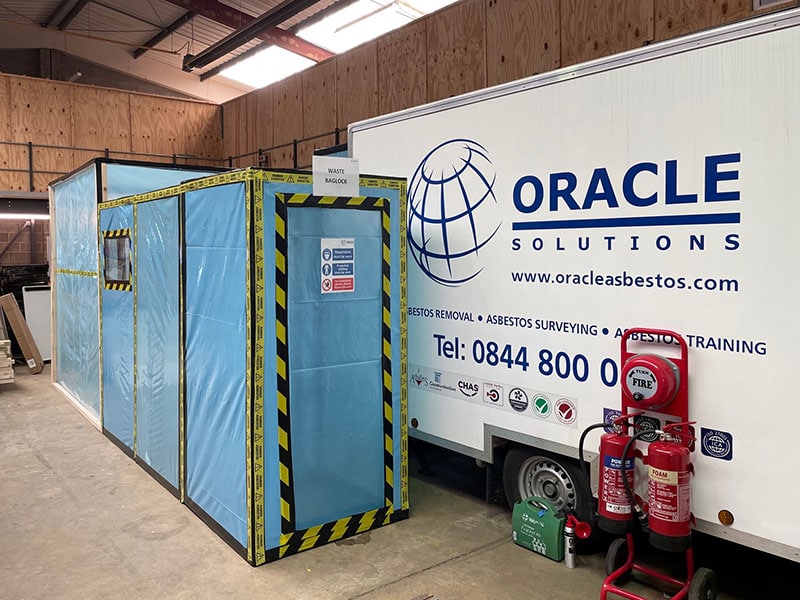What is a four-stage asbestos clearance test?
If you know anything at all about asbestos removal as a building owner or manager, you are likely to have heard of the four-stage clearance process.
The four-stage clearance test must be performed after licensed asbestos-containing materials (ACMs) have been taken out of a given space – in other words, materials for which a Health and Safety Executive (HSE) licence is required in order for removal to be undertaken.
As a result of this procedure being successfully carried out through all four stages, it can be ensured that the former location of the removed ACMs is thoroughly clean – and can therefore be safely returned to the owner or occupier.
So, there are both safety and regulatory reasons to arrange a four-stage clearance test for asbestos removal. If this process is successfully completed, it will serve as confirmation of the asbestos removal work’s compliance with the requirements of the Control of Asbestos Regulations 2012 (CAR 2012).

Why is a four-stage asbestos clearance test legally required?
As aforementioned, it is CAR 2012 – the overarching legislation in relation to asbestos management in Great Britain – that provides the legal basis for the four-stage clearance test.
Ultimately, this four-stage clearance procedure is crucial for reasons of health, safety, and compliance. Crucially, the assessment cannot be undertaken by the licensed contractor that was hired to remove the ACMs in question.
Instead, the four-stage clearance test needs to be carried out by an independent organisation that is accredited by the United Kingdom Accreditation Service (UKAS), in accordance with ISO 17025. The latter is the international standard outlining general requirements whereby laboratories can achieve competence, impartiality, and consistent operations.
This separation of duties enables the four-stage clearance process to satisfy its purpose as a form of independent verification and reassurance.
Who is qualified to carry out a four-stage clearance test?
If you need to arrange a four-stage clearance process in the UK, you must ensure it is carried out by an independent and qualified analyst. This will mean seeking out an analyst that is UKAS-accredited under ISO 17025 standards, and that is not affiliated with your chosen asbestos removal contractor – thereby ensuring you can be confident in their impartiality.
In order for a given individual to be a competent asbestos analyst, they will typically need to have qualifications such as the Royal Society for Public Health (RSPH)’s Level 3 Award in Air Monitoring and Clearance Procedures, or the British Occupational Hygiene Society (BOHS)’s P403 and P404 technical modules.
The P404 qualification, for instance, is entitled Clearance Testing and the Requirements of a Certificate for Reoccupation. It equips the given analyst with the skills and knowledge they require in order to carry out all four stages of the clearance process safely and thoroughly.
What happens during the first stage – the preliminary site condition check?
The asbestos analyst will begin the four-stage clearance test by reviewing the site and the work carried out by the removal contractor.
You can expect the analyst who visits your site to scrutinise the contractor’s documentation – including their licence, plan of work, and notifications – to make sure it is all in order.
This stage also entails checking the scope of the job – in other words, what was supposed be removed – along with inspection of the asbestos removal enclosure, containment measures, and preliminary cleanliness. The analyst will also want to be convinced that transit and waste routes don’t have any obvious contamination.
This first stage effectively sets the foundation for the broader four-stage process, confirming that the work carried out aligns with the agreed plan. Once the asbestos analyst has verified this initial compliance, they will be able to move onto the next stage.
What happens during the second stage – the thorough visual inspection?
Until this stage, the analyst won’t have entered the asbestos enclosure to take a more detailed, “hands-on” look at the situation inside. But during this second stage, they will now do so.
The analyst’s aim during this stage will be scrutinising every surface – including the walls, floors, ceilings, and hidden spots, such as folds in the enclosure material – to ascertain that there is no remaining visible asbestos debris, dust or residue.
This thorough visual examination – also sometimes referred to as the “fingertip visual inspection” method – will seek to ensure the area is dry and clean.
In the event of any leftover ACMs being found at this point, the contractor will need to address this before further progress can be made.
How is the third stage – air monitoring – conducted?
This asbestos air monitoring stage – also sometimes referred to as “asbestos air testing” – entails the use of specialised equipment to capture samples of air inside the enclosure. This is followed by on-site counting of the fibres, using the phase contrast microscopy (PCM) method.
A particularly vital aspect of this stage of the four-stage procedure, is the deliberate disturbance of surfaces in order to simulate real occupancy conditions. This is done by brushing the work enclosure at the start of the sample run, thereby kicking up any unseen, fine-settled dust that could potentially contain asbestos fibres.
When the analyst looks at the results of the PCM process, they will be seeking to ensure a concentration of less than 0.01 asbestos fibres per cubic centimetre of air (f/cm3). If this is achieved, the levels of asbestos fibres in the air can essentially be considered safe. From there, stage three can be signed off, in readiness for the enclosure being dismantled.
As for if the recorded concentration is higher than 0.01 f/cm3, it will be necessary for further cleaning and retesting to be carried out.
What is assessed during the fourth stage – the final assessment?
Presuming the result of the air test allows this stage to be undertaken, it will finally be time for the enclosure to be dismantled, alongside all equipment and materials being removed from the space.
It is important to be alert, though, to the possibility that even the dismantling stage could cause the release of some lingering asbestos fibres – for example, from the folds of the enclosure material.
This is why it will be crucial for the asbestos analyst to undertake one, final check and assessment. This will need to involve checks on transit routes and surrounding areas, to make sure no trapped asbestos or debris was missed in the process of taking the enclosure down.
Such a final check will allow for confirmation that the entire area is clear and safe to use in a normal way, without anyone in the space requiring protective gear.
Fortunately, even in the event of any minor issues coming up at this stage – and any such issues will almost certainly be minor ones – it will normally be easy to clean them prior to the sign-off of the final stage.
What happens after the successful completion of the four-stage clearance test?
If the asbestos analyst is satisfied after the aforementioned four stages that the given space is clean and safe, they can sign off the last stage, and a “Certificate of Reoccupation” can be issued. This certificate will set out details on any failures and any necessary remedial actions.
As part of the overall four-stage clearance test, the Decontamination Unit (DCU) will need to be subject to a separate inspection and clearance process. Again, the emphasis will be on ensuring the DCU is clean and free of asbestos.
Remember that if failure occurs at any of the aforementioned four stages, it will be necessary to loop back – through cleaning, retesting, and even potentially rebuilding the enclosure – until the required standard has been met.
Conclusion: the four-stage clearance process plays a critical role
It cannot be asserted enough, just how important it is to ensure a thorough and compliant clearance process following the removal of licensed ACMs from a given location.
As we spoken about here, you should be motivated by both health and safety concerns, and an awareness of the importance of legal compliance, when you are seeking out and hiring an analyst to see through the four-stage clearance procedure.
Through the proactive management and planning of clearance tests at any premises that you own, manage, or are otherwise responsible for, you can go a long way to protecting building occupants and users, while also giving yourself the utmost peace of mind.
For further information about any of our asbestos services at Oracle Solutions, and to request a free and fast quote, please contact us via phone or email today.

Written by Mark Carter
Mark Carter is a renowned expert in asbestos management, offering clients vital guidance on compliance and safety. His expertise is invaluable for navigating asbestos regulations, ensuring both safety and legal adherence. Mark's role is central in providing effective asbestos-related solutions, helping clients achieve their business objectives with an emphasis on regulatory compliance and safety in asbestos management.
